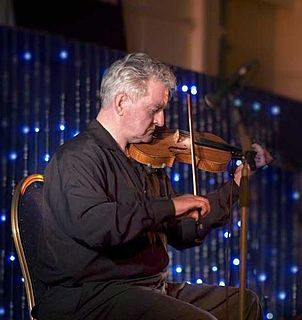
The Donegal fiddle tradition is the way of playing the fiddle that is traditional in County Donegal, Ireland. It is one of the distinct fiddle traditions within Irish traditional music.

Turlough O'Carolan, was a blind Celtic harper, composer and singer in Ireland whose great fame is due to his gift for melodic composition.

A Hardanger fiddle is a traditional stringed instrument used originally to play the music of Norway. In modern designs, this type of fiddle is very similar to the violin, though with eight or nine strings and thinner wood. Four of the strings are strung and played like a violin, while the rest, aptly named understrings or sympathetic strings, resonate under the influence of the other four.
Old-time music is a genre of North American folk music. It developed along with various North American folk dances, such as square dancing, clogging, and buck dancing. It is played on acoustic instruments, generally centering on a combination of fiddle and plucked string instruments, as well as the mandolin.
Jerry Holland was a musician and fiddler who lived on Cape Breton Island in Nova Scotia, Canada.
Here Northumbria is taken to mean Northumberland, the northernmost county of England, and County Durham, as is defined by the Oxford English Dictionary. This area, together with Tweeddale, was the ancient British tribal kingdom of Bernicia (Bryneich) and is notable for the stable ancestry of its present indigenous population, which has been identified by DNA analysis to be an offshoot of the group Scotland, Cumbria and the North of Ireland, but not so closely related to the other peoples of the UK. The area was the core of the outstanding artistic culture that developed during the Northumbrian Golden Age of the 7th and 8th centuries; it would be unwise to suggest that the area did not have a flourishing musical culture at that time, or that it was not of similar sophistication - Bede makes reference to the playing of the harp.

Cape Breton fiddling is a regional violin style which falls within the Celtic music idiom. Cape Breton Island's fiddle music was brought to North America by Scottish immigrants during the Highland Clearances. These Scottish immigrants were primarily from Gaelic-speaking regions in the Scottish Highlands and the Outer Hebrides. Although fiddling has changed considerably since this time in Scotland, it is widely held that the tradition of Scottish fiddle music has been better preserved in Cape Breton.

The Irish fiddle is one of the most important instruments in the traditional repertoire of Irish music. The fiddle itself is identical to the violin, however it is played differently in widely varying regional styles. In the era of sound recording some regional styles have been transmitted more widely while others have become more uncommon.
"Cluck Old Hen" is a popular Appalachian fiddle and banjo tune in the mixolydian or dorian mode. It is played either as an instrumental or with lyrics, which vary from one version to another. One of the earliest reported transcriptions of the tune dates from 1886. The earliest recording is attributed to Fiddlin' John Carson, in 1923.

Kenneth Clayton Baker was an American fiddle player best known for his 25-year tenure with Bill Monroe and his group The Blue Grass Boys.
This is a chart of stringed instrument tunings. Instruments are listed alphabetically by their most commonly known name.
John Durang was the first native-born American to become known as a dancer. Said to be George Washington's favorite performer, he was famous for dancing the hornpipe, a lively, jiglike solo exhibition so called because it was originally performed to music played on a woodwind instrument known as a hornpipe.
Calvin Vollrath is a Canadian fiddler and composer and is one of the few European-Canadian fiddle players playing professionally in the Métis style. He lives in St. Paul, Alberta.

The National Oldtime Fiddlers' Contest is an old-time music competition, festival, and musical gathering in the western United States, held annually during the third full week in June in Weiser, Idaho, about fifty miles (80 km) northwest of Boise. Within the fiddling community, it is often referred to simply as "Weiser," and the contest draws musicians from across the country.

American fiddle-playing began with the early settlers who found that the small viol family instruments were portable and rugged. According to Ron Yule, "John Utie, a 1620 immigrant, settled in the North and is credited as being the first known fiddler on American soil". Early influences were Irish fiddle styles as well as Scottish and the more refined traditions of classical violin playing. Popular tunes included "Soldier's Joy", for which Robert Burns had written lyrics, and other such tunes as "Flowers of Edinburgh" and "Tamlin," which were claimed by both Scottish and Irish lineages.

Old time fiddle is a genre of American folk music. "Old time fiddle tunes" derived from European folk dance tunes such as Jig, Reel, Breakdown, Schottische, Waltz, Two Step and Polka. The fiddle may be accompanied by banjo or other instruments but are nevertheless called "fiddle tunes". The genre traces from the colonization of North America by immigrants from England, France, Germany, Ireland, and Scotland. It is separate and distinct from traditions which it has influenced or which may in part have evolved from it, such as bluegrass, country blues, variants of western swing and country rock.

Canadian fiddle is the aggregate body of tunes, styles and musicians engaging the traditional folk music of Canada on the fiddle. It is an integral extension of the Anglo-Celtic and Québécois Frenchfolk music tradition but has distinct features found only in the Western hemisphere.
Bluegrass fiddling is a distinctive style of American fiddle playing which is characterized by bold, bluesy improvisation, off-beat "chopping", and sophisticated use of both double-stops and old-time bowing patterns.













